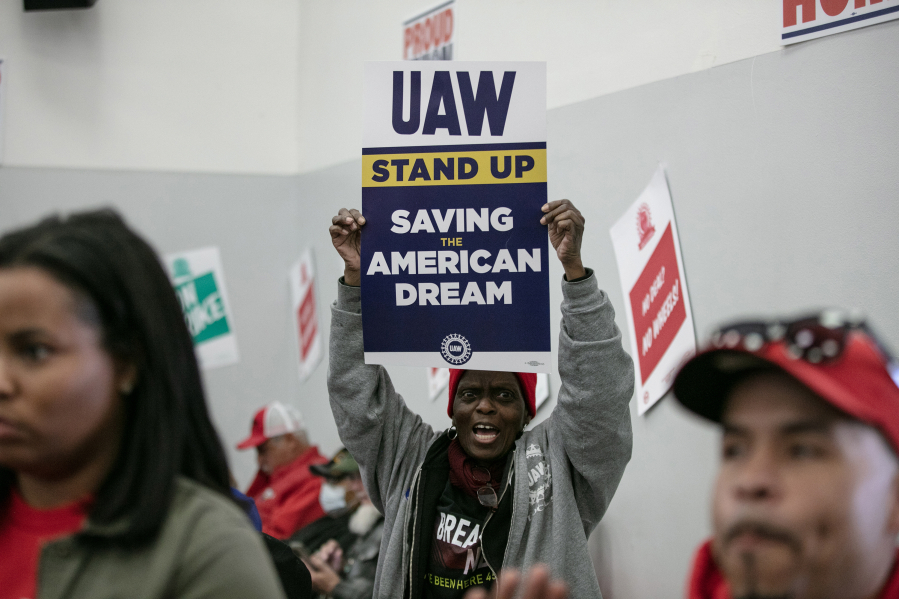SPOKANE — In a year full of worker stoppages — from writers and actors striking in Los Angeles to autoworkers in the Midwest — it seemed like unions had somehow figured out how to claw back into labor discussions as the economy continues to recover from the COVID-19 pandemic.
But numbers released this week by the U.S. Bureau of Labor Statistics show that union membership has continued its decades-long slide and hit a record low of 10% among all wage and salary workers.
The drop also was deep in Washington, which has the third-highest number of union workers in the nation. Despite efforts to unionize Starbucks and Amazon, the percentage of union workers fell from 18% in 2022 to 16.5% in 2023, according to the federal statistics.
Marty Hodgson, president of the United Steel Workers local 338, which represents employees at the Kaiser Trentwood rolling mill in Spokane Valley, said the numbers were troubling.
“We always worry about union membership dropping,” Hodgson said. “I don’t know exactly the reason why it’s dropping. It’s been on a steady decline.”
In a statement, April Sims, president of the Washington State Labor Council, AFL-CIO, noted that labor statistics show national union membership actually grew in 2023 by about 139,000 positions.
Job growth, however, outpaced the number of union jobs, which led to the decline from 10.1% in 2022 to 10% last year.
“Today in Washington state and across the country, union organizing, worker activism, and public support of unions are all higher than they’ve been in our lifetimes,” Sims said in the statement. “The fact that these latest numbers don’t reflect that enthusiasm should be a concern for all Americans.”
Sims said most Americans support the idea of joining a union, including about 90% of young workers.
“The answer is that there are too many obstacles to joining together in unions. Corporate union-busters spend billions to deny workers their rights,” she said. “Anti-worker politicians and Supreme Court justices continue to create roadblocks. They do this because the rich and powerful know that unions work.”
The numbers highlight a disconnect between historically strong public support for unions and their ability to attract new members.
That’s occurring despite major contract wins at companies like United Parcel Service Inc. and Detroit’s Big Three automakers, as well as renewed support from President Joe Biden to the AFL-CIO, the nation’s largest labor federation.
Despite those declines, unions demonstrated their power through strikes last year: More than half a million people walked off the job, according to Bloomberg Law’s database of work stoppages, with auto workers and Hollywood writers and actors scoring historic job benefits and protections.
Those wins will give unions good momentum heading into the new year.
Labor leaders like the United Auto Workers’ president Shawn Fain have set audacious goals for 2024 and beyond, looking to organize companies like Tesla Inc.
Those who organize
According to national statistics, the vast majority of union membership comes in public-sector jobs versus private.
In 1983, the first year the government began tracking union membership, some 16.8% of private nonagricultural industries were held by union members. In 2023, that percentage dropped to 6.1%.
The decline has been less fierce for public workers. In 1983, some 37% were part of a union. That number fell to 32.5% last year, according to the statistics.
Among those public jobs, the highest percentage of workers (32.7%) worked in education, training and library jobs.
Those with the least representation worked in public sales (2.9%), food preparation (3.2%) and management jobs (4.1%).
Sims, of the state’s AFL-CIO, noted that union jobs continue to pay about 15.9% better than nonunion jobs.
“Life is truly better in a union,” Sims said in the statement.
Hodgson, of the United Steel Workers local that has about 880 members, agreed with Sims. He said organized workers and Kaiser managers have worked together for the benefit of both sides following the devastating strike and lockout at Kaiser between 1998 and 2000.
Hodgson, who has worked 36 years at Kaiser, was part of that labor dispute.
“Some of those unions go in and the company is always wrong, and they say we deserve this and that,” Hodgson said. “Our relationship is quite a bit different. We work well together.
“They have happier employees for better production and, on the union side, we make working conditions better. It’s kind of a win-win.”
And, union members have a clear idea and have better access to quality medical and retirement benefits, he said.
“It’s not just wages,” he said. “I talk to a lot of people who are not in a union. With Kaiser, we have excellent benefits. That’s huge in this time, to have the medical benefits that we have.”



